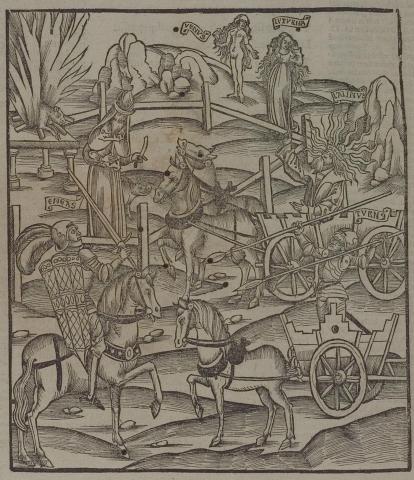Annotations
In the upper right of the image, Venus, who should be Juno, stands next to Juturna, the goddess sister of Turnus, and tells her of Turnus's fate (134-60). Latinus rides in a chariot toward the ring wearing a crown made to look like the Sun (161-4). He makes a sign of blessing with his hand. Turnus rides in next to him, holding two spears (164-5). On the left, a priest sacrifices two boars (169-71). Below this, Aeneas raises his sword and swears an oath that he will abide by the terms of the combat, however fate decides the outcome (175-94). Latinus's raised hand may signify his own oath sworn after Aeneas's, but it is unclear, since he does not hold a sceptre (195-211).
Woodcut illustration from the “Strasbourg Vergil,” edited by Sebastian Brant: Publii Virgilii Maronis Opera cum quinque vulgatis commentariis expolitissimisque figuris atque imaginibus nuper per Sebastianum Brant superadditis (Strasbourg: Johannis Grieninger, 1502), fol. 395v, executed by an anonymous engraver under the direction of Brant.


Sebastian Brant (1458-1521) was a humanist scholar of many competencies. Trained in classics and law at the University of Basel, Brant later lectured in jurisprudence there and practiced law in his native city of Strasbourg. While his satirical poem Das Narrenschiff won him considerable standing as a writer, his role in the transmission of Virgil to the Renaissance was at least as important. In 1502 he and Strasbourg printer Johannes Grüninger produced a major edition of Virgil’s works, along with Donatus’ Life and the commentaries of Servius, Landino, and Calderini, with more than two hundred woodcut illustrations. (Annabel Patterson)